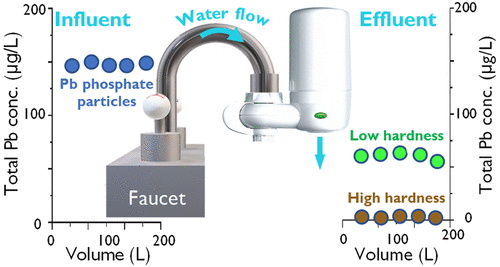当前位置:
X-MOL 学术
›
Environ. Sci. Technol. Lett.
›
论文详情
Our official English website, www.x-mol.net, welcomes your
feedback! (Note: you will need to create a separate account there.)
Lead Phosphate Particles in Tap Water: Challenges for Point-of-Use Filters
Environmental Science & Technology Letters ( IF 8.9 ) Pub Date : 2021-02-26 , DOI: 10.1021/acs.estlett.1c00055 Weiyi Pan 1 , Elizabeth R. Johnson 1 , Daniel E. Giammar 1
Environmental Science & Technology Letters ( IF 8.9 ) Pub Date : 2021-02-26 , DOI: 10.1021/acs.estlett.1c00055 Weiyi Pan 1 , Elizabeth R. Johnson 1 , Daniel E. Giammar 1
Affiliation

|
To lower Pb concentrations in tap water, water systems implement corrosion control treatment that often involves the addition of orthophosphate. Because NSF/ANSI 53 (2018) certified point-of-use (POU) filters can remove Pb from tap water to less than 10 μg Pb/L, they are often distributed in emergencies or as follow-up steps to lead service line removals or disturbances. While these filters are certified for the removal of both soluble and particulate lead, this study reported that Pb phosphate particles can penetrate POU filters under certain conditions. The small sizes and negative surface charges of suspended Pb phosphate particles make them more mobile through the solid block activated carbon media of POU filters. When tested using challenging water containing 150 μg Pb/L, 2 mM ionic strength (IS), and no hardness at pH 7.0, 41% of the Pb passed through the POU filters. However, when IS was increased to 50 mM or Ca was increased to 0.5 mM, the amount of Pb penetrating the POU filters decreased to 32% and 17%, respectively. Adsorption of Ca onto Pb phosphate particles and high IS promotes aggregation and enhances POU filter performance.
中文翻译:

自来水中的磷酸铅颗粒:使用点过滤器的挑战
为了降低自来水中的Pb浓度,水系统实施了腐蚀控制处理,该处理通常涉及添加正磷酸盐。由于获得NSF / ANSI 53(2018)认证的使用点(POU)过滤器可以将自来水中的Pb去除至小于10μgPb / L,因此它们通常会在紧急情况下分发或作为后续步骤以去除服务线或干扰。虽然这些过滤器均经过认证,可去除可溶性铅和颗粒状铅,但该研究报告称,在某些条件下,磷酸铅颗粒可以穿透POU过滤器。悬浮的Pb磷酸盐颗粒的小尺寸和负表面电荷使它们更易于通过POU过滤器的固体块状活性炭介质流动。当使用含有150μgPb / L,2 mM离子强度(IS)且在pH 7.0下无硬度的高挑战性水进行测试时,41%的Pb通过POU过滤器。但是,当IS增加到50 mM或Ca增加到0.5 mM时,穿透POU过滤器的Pb量分别减少到32%和17%。Ca在Pb磷酸盐颗粒上的吸附和高IS促进聚集并增强POU过滤器的性能。
更新日期:2021-03-09
中文翻译:

自来水中的磷酸铅颗粒:使用点过滤器的挑战
为了降低自来水中的Pb浓度,水系统实施了腐蚀控制处理,该处理通常涉及添加正磷酸盐。由于获得NSF / ANSI 53(2018)认证的使用点(POU)过滤器可以将自来水中的Pb去除至小于10μgPb / L,因此它们通常会在紧急情况下分发或作为后续步骤以去除服务线或干扰。虽然这些过滤器均经过认证,可去除可溶性铅和颗粒状铅,但该研究报告称,在某些条件下,磷酸铅颗粒可以穿透POU过滤器。悬浮的Pb磷酸盐颗粒的小尺寸和负表面电荷使它们更易于通过POU过滤器的固体块状活性炭介质流动。当使用含有150μgPb / L,2 mM离子强度(IS)且在pH 7.0下无硬度的高挑战性水进行测试时,41%的Pb通过POU过滤器。但是,当IS增加到50 mM或Ca增加到0.5 mM时,穿透POU过滤器的Pb量分别减少到32%和17%。Ca在Pb磷酸盐颗粒上的吸附和高IS促进聚集并增强POU过滤器的性能。











































 京公网安备 11010802027423号
京公网安备 11010802027423号